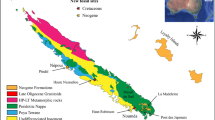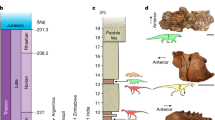Abstract
The Triassic period documents the origin and diversification of modern amniote lineages and the Late Triassic fossil record of South America has been crucial to shed light on these early evolutionary histories. However, the faunistic changes that led to the establishment of Late Triassic ecosystems are largely ignored because of the global scarcity of fossils from assemblages a few million years older. Here we contribute to fill this gap with the description of a new tetrapod assemblage from the lowermost levels of the Chañares Formation (uppermost Middle–lower Late Triassic epochs) of Argentina, which is older than the other vertebrate assemblages of the same basin. The new assemblage is composed of therapsids, rhynchosaurids and archosaurs, and clearly differs from that of the immediately overlying and well-known historical Chañares vertebrate assemblage. The new tetrapod association is part of a phase of relatively rapidly changing vertebrate assemblage compositions, in a time span shorter than 6 million years, before the diversification of dinosaurs and other common Late Triassic tetrapods in southwestern Pangaea.
This is a preview of subscription content, access via your institution
Access options
Access Nature and 54 other Nature Portfolio journals
Get Nature+, our best-value online-access subscription
$29.99 / 30 days
cancel any time
Subscribe to this journal
Receive 12 digital issues and online access to articles
$119.00 per year
only $9.92 per issue
Buy this article
- Purchase on SpringerLink
- Instant access to full article PDF
Prices may be subject to local taxes which are calculated during checkout



Similar content being viewed by others
References
Bakker, R. T. in Patterns of Evolution as illustrated by the Fossil Record (ed. Hallan, A.) 439–468 (Elsevier, Amsterdam, 1977).
Benton, M. J., Tverdokhlebov, V. P. & Surkov, M. V. Ecosystem remodelling among vertebrates at the Permian–Triassic boundary in Russia. Nature 432, 97–100 (2004).
Nesbitt, S. J. The early evolution of archosaurs: relationships and the origin of major clades. Bull. Am. Mus. Nat. Hist. 352, 1–292 (2011).
Ezcurra, M. D. The phylogenetic relationships of basal archosauromorphs, with an emphasis on the systematics of proterosuchian archosauriforms. PeerJ 4, e1778 (2016).
Martinelli, A. G. & Bento Soares, M. in Historia Evolutiva y Paleobiogeográfica de los Vertebrados de América del Sur (eds. Agnolín, F. L., Lio, G. L., Brissón Egli, F., Chimento, N. & Novas, F. E.) 183–197 (Contribuciones del MACN 6, 2016).
Liu, J. & Olsen, P. The phylogenetic relationships of Eucynodontia (Amniota: Synapsida). J. Mamm. Evol. 17, 151–176 (2010).
Ruta, M., Botha-Brink, J., Mitchell, S. A. & Benton, M. J. The radiation of cynodonts and the ground plan of mammalian morphological diversity. Proc. R. Soc. B 280, 20131865 (2013).
Brusatte, S. L. et al. The origin and early radiation of dinosaurs. Earth Sci. Rev. 101, 68–100 (2010).
Langer, M. C., Ezcurra, M. D., Bittencourt, J. & Novas, F. E. The origin and early evolution of dinosaurs. Biol. Rev. Camb. Philos. Soc. 85, 55–110 (2010).
Abdala, F. & Ribeiro, A. M. Distribution and diversity patterns of Triassic cynodonts (Therapsida, Cynodontia) in Gondwana. Palaeogeogr. Palaeoclimatol. Palaeoecol. 286, 202–217 (2010).
Bonaparte, J. F. Faunal replacement in the Triassic of South America. J. Vertebr. Paleontol. 2, 362–371 (1982).
Benton, M. J. Dinosaur success in the Triassic: a non-competitive ecological model. Q. Rev. Biol. 58, 29–55 (1983).
Romer, A. S. The Chãnares (Argentina) Triassic reptile fauna: I. Introduction. Breviora 247, 1–14 (1966).
Romer, A. S. The Chañares (Argentina) Triassic reptile fauna: XX. Summary. Breviora 413, 1–20 (1973).
Rogers, R. R. et al. Paleoenvironment and taphonomy of the Chañares Formation tetrapod assemblage (Middle Triassic), northwestern Argentina: spectacular preservation in volcanogenic concretions. Palaios 16, 461–481 (2001).
Marsicano, C. A. et al. The precise temporal calibration of dinosaur origins. Proc. Natl Acad. Sci. USA 113, 509–513 (2015).
Fiorelli, L. E. et al. The oldest known communal latrines provide evidence of gregarism in Triassic megaherbivores. Sci. Rep. 3, 3348 (2013).
Crompton, A. W. & Parrington, F. R. On some Triassic cynodonts from Tanganyika. Proc. Zool. Soc. Lond. 125, 617–669 (1955).
Martinelli, A. G. et al. The African cynodont Aleodon (Cynodontia, Probainognathia) in the Triassic of southern Brazil and its biostratigraphic significance. PLoS ONE 12, e0177948 (2017).
Ezcurra, M. D. et al. The oldest rhynchosaur from Argentina: a Middle Triassic rhynchosaurid from the Chañares Formation (Ischigualasto–Villa Unión Basin, La Rioja Province). Paläontol. Z. 88, 453–460 (2014).
Arcucci, A. B. & Marsicano, C. A. A distinctive new archosaur from the Middle Triassic (Los Chañares Formation) of Argentina. J. Vertebr. Paleontol. 18, 228–232 (1998).
Desojo, J. B., Ezcurra, M. D. & Schultz, C. L. An unusual new archosauriform from the Middle–Late Triassic of southern Brazil and the monophyly of Doswelliidae. Zool. J. Linn. Soc. 161, 839–871 (2011).
Sereno, P. C. Basal archosaurs: phylogenetic relationships and functional implications. Mem. Soc. Vertebr. Paleontol. 2, 1–53 (1991).
Mancuso, A. C., Gaetano, L. C., Leardi, J. M., Abdala, F. & Arcucci, A. B. The Chañares Formation: a window to a Middle Triassic tetrapod community. Lethaia 47, 244–265 (2014).
Alroy, J. Geographical, environmental and intrinsic biotic controls on Phanerozoic marine diversification. Palaeontology 53, 1211–1235 (2010).
Schultz, C. L., Scherer, C. M. S. & Barberena, M. C. Biostratigraphy of southern Brazilian Middle–Upper Triassic. Rev. Bras. Geociênc. 30, 495–498 (2000).
Langer, M. C., Ribeiro, A. M., Schultz, C. L. & Ferigolo, J. The continental tetrapod-bearing Triassic of South Brazil. Bull. New Mexico Mus. Nat. Hist. Sci. 41, 201–218 (2007).
Schultz, C. L., Langer, M. C. & Montefeltro, F. C. A new rhynchosaur from south Brazil (Santa Maria Formation) and rhynchosaur diversity patterns across the Middle–Late Triassic boundary. Paläontol. Z. 90, 593–609 (2016).
Abdala, F. & Sá-Teixeira, A. M. A traversodontid cynodont of African affinity in the South American Triassic. Palaeontol. Afr. 40, 11–22 (2004).
Nesbitt, S. J. et al. Ecologically distinct dinosaurian sister-group shows early diversification of Ornithodira. Nature 464, 95–98 (2010).
Raath, M. A. Earliest evidence of dinosaurs from central Gondwana. Mem. Queensl. Mus. 39, 703–709 (1996).
Raath, M. A., Oesterlen, P. M. & Kitching, J. W. First record of Triassic Rhynchosauria (Reptilia: Diapsida) from the Lower Zambezi Valley, Zimbabwe. Palaeontol. Afr. 29, 1–10 (1992).
Langer, M. C. Studies on continental Late Triassic tetrapod biochronology. II. The Ischigualastian and a Carnian global correlation. J. S. Am. Earth Sci. 19, 219–239 (2005).
Nesbitt, S. J. et al. The earliest bird-line archosaurs and the assembly of the dinosaur body plan. Nature 544, 484–487 (2017).
Stocker, M. R., Zhao, L. J., Nesbitt, S. J., Wu, X. C. & Li, C. A short-snouted, Middle Triassic phytosaur and its implications for the morphological evolution and biogeography of Phytosauria. Sci. Rep. 7, 46028 (2017).
Goloboff, P. A., Farris, J. S. & Nixon, K. C. TNT: a free program for phylogenetic analysis. Cladistics 24, 774–786 (2008).
Goloboff, P. A. & Catalano, S. A. TNT version 1.5, including a full implementation of phylogenetic morphometrics. Cladistics 32, 221–238 (2016).
Sato, K., Santosh, M., Tsunogae, T., Chetty, T. R. K. & Hirata, T. Subduction accretion–collision history along the Gondwana suture in southern India: a laser ablation ICP-MS study of zircon chronology. J. Asian Earth Sci. 40, 162–171 (2011).
Ludwig, K. R. Isoplot/Ex v.3.0: A Geochronological Toolkit for Microsoft Excel. (Geochronology Center Special Publication 4, Berkeley, 2003).
Acknowledgements
We thank the Secretaría de Cultura de La Rioja and the Administración de Parques Nacionales for granting permits to work in the Talampaya National Park and the field crews of 2011–2014 and 2016–2017; the rangers of the National Park for their help in the field; J. F. Bonaparte, S. J. Nesbitt, C. L. Schultz and M. B. Soares for discussions on the Chañares Formation; J. Kaluza, M. Cárdenas, G. Aguirrezabala, L. Acosta, F. Solari Orellana, A. Lecuona, R. Barros, M. Iberlucea, A. Bustamante and S. de la Vega for preparation of fossil material. Research was funded by the Agencia Nacional de Investigaciones Científicas y Técnicas (PICT 2012-0925 and PICT 2014-0609 to J.B.D.), The Jurassic Foundation (to M.D.E.), Secretaría de Gobierno, La Rioja (to L.E.F.), Conselho Nacional de Desenvolvimento Científico e Tecnológico (CNPq, to A.G.M.) and Universidad Nacional de San Juan (PROJOVI, UNSJ-SECITI to M.J.T.).
Author information
Authors and Affiliations
Contributions
M.D.E., L.E.F. and J.B.D. designed the research project; all authors conducted fieldwork; M.D.E., L.E.F., A.G.M., M.B.v.B. and J.B.D. described the material; M.D.E., M.B.v.B. and J.B.D. conducted the phylogenetic analyses; S.R. and M.E. conducted the geologic studies; all the authors contributed to the text of the manuscript; M.D.E., L.E.F., A.G.M., S.R., M.B.v.B., J.R.A.T., E.M.H. and M.J.T. made the figures.
Corresponding author
Ethics declarations
Competing interests
The authors declare no competing financial interests.
Additional information
Publisher’s note: Springer Nature remains neutral with regard to jurisdictional claims in published maps and institutional affiliations.
Electronic supplementary material
Supplementary Information
Supplementary Figures, Supplementary Description, Supplementary Information of the Datings and Supplementary References
Supplementary Data 1
Skeletal and skull reconstructions of Tarjadia ruthaeSkeletal and skull reconstructions of Tarjadia ruthae
Supplementary Data 2
TNT data matrix used for the phylogenetic analysis
Supplementary Data 3
NEXUS data matrix used for the phylogenetic analysis
Supplementary Data 4
Detailed information of the dated zircons of the sample AM-260
Supplementary Data 5
Detailed information of the dated zircons of the sample AM-242
Supplementary Data 6
R script for the sampling simulations
Rights and permissions
About this article
Cite this article
Ezcurra, M.D., Fiorelli, L.E., Martinelli, A.G. et al. Deep faunistic turnovers preceded the rise of dinosaurs in southwestern Pangaea. Nat Ecol Evol 1, 1477–1483 (2017). https://doi.org/10.1038/s41559-017-0305-5
Received:
Accepted:
Published:
Issue Date:
DOI: https://doi.org/10.1038/s41559-017-0305-5
This article is cited by
-
A redescription of Trachelosaurus fischeri from the Buntsandstein (Middle Triassic) of Bernburg, Germany: the first European Dinocephalosaurus-like marine reptile and its systematic implications for long-necked early archosauromorphs
Swiss Journal of Palaeontology (2024)
-
Scleromochlus and the early evolution of Pterosauromorpha
Nature (2022)
-
Eifelosaurus triadicus Jaekel, 1904, a “forgotten” reptile from the Upper Buntsandstein (Triassic: Anisian) of the Eifel region, Germany
PalZ (2022)
-
Enigmatic dinosaur precursors bridge the gap to the origin of Pterosauria
Nature (2020)
-
Early evidence of molariform hypsodonty in a Triassic stem-mammal
Nature Communications (2019)




